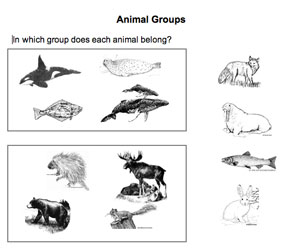Formative Assessment Probes
The brief, formative assessment resources included with these units are called "assessment probes." They are called "probes" because they are designed to probe and uncover student thinking. Teacher and researcher Page Keeley has written extensively about the probes as part of the Curriculum Topic Study approach to analyzing science and mathematics topics. See the Curriculum Topic Study website for more information.
These probes are designed to be used diagnostically and formatively. They are intended to help you to tap into students' thinking about particular science topics—topics that are identified by the National Science Education Standards as significant and developmentally appropriate for the target age level of the unit. While they are intended to sample students' thinking (and to probe for common misconceptions), they are NOT intended to measure what students have learned as a result of the unit content. We encourage you to use these tools—and to develop your own—to better understand each student's development as a learner, and to modify your teaching accordingly.
Purpose
The purpose of this probe is to assess students’ abilities to recognize different characteristics of animals and to classify according to those characteristics. Eliciting the justification for their decisions will reveal students' level of understanding.
Explanation
Each animal in the top group has fins or flippers, but no legs. The bottom group includes animals that have four legs. The fox and rabbit belongs in the group of animals that have legs and the walrus and the salmon belong in the group that have no legs. Students may come up with different groupings for the two main groups. This is fine as long as they can support their reasoning. If they choose "land animals" and "water animals", you might ask them if the animals that live on land (or in the water) have something in common. This will help them recognize a particular characteristic.
Children at this age can only be expected to use two groups at the same time when sorting. In later years they are able to use a number of sorting groups at the same time. "By the age of 13, most children, when asked, could use the group 'animals' to include groups such as 'bird', and by the age of 16 most students used hierarchical classifcation more spontaneously." (Making Sense of Secondary Science, p24).
Administering the Probe
The teacher should present the scenario, then ask students to write or tell the reasoning for their choices. This justification is critical to assessing their level of understanding and/or misconceptions. We suggest that this probe be administered in small groups or one-on-one, to help with reading the probe. This setting will also ensure that the students' reasoning is clear, whether their responses are verbal or written. Teacher prompting may be needed for students to go beyond guessing, to explain and/or elaborate on their responses to clarify their level of understanding. Non-leading prompts in a neutral tone of voice might include: Tell me more… Why did you choose that response?
Grade Level Curricular and Instructional Considerations "Biologists classify organisms into a hierarchy of groups and subgroups on the basis of similarities and differences in their structure and behavior."(Science for All Americans, p. 60).
"In the beginning, children can focus on any attribute – size, color, limbs, fins, or wings – but then should gradually be guided to realize that for purposes of understanding relatedness among organisms, some characteristics are more significant than others." (Benchmarks for Science Literacy, p.101)
"By the end of 2nd grade, students should know that some animals and plants are alike in the way they look and in the things they do, and others are very different from one another." (Benchmarks for Science Literacy, p.102)
"In classroom activities such as classification, younger elementary students generally use mutually exclusive rather than hierarchical categories. Young children, for example, will use two groups, but older children will use several groups at the same time. Students do not consistently use classification schemes similar to those used by biologists until the upper elementary grades." (National Science Education Standards, p.128)
Related National Science Education Standards
K - 4 The Characteristics of Organisms
- Organisms have basic needs. For example, animals need air, water, and food; plants require air, water, nutrients, and light. Organisms can survive only in environments in which their needs can be met. The world has many different environments, and distinct environments support the life of different types of organisms.
- Each plant or animal has different structures that serve different functions in growth, survival, and reproduction. For example, humans have distinct body structures for walking, holding, seeing, and talking.
K- 2 Diversity of Life
- Some animals and plants are alike in the way they look and in the things they do, and others are very different from one another.
- Plants and animals have features that help them live in different environments.
3-5 Diversity of Life
- A great variety of kinds of living things can be sorted into groups in many ways using various features to decide which things belong to which group.
- Features used for grouping depend on the purpose of the grouping.
Related Probes in Uncovering Student Ideas in Science by Page Keeley:
Is it a Plant? V2, p.93
Is it an Animal? V1, p.117










